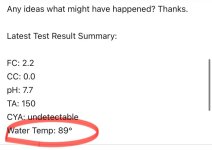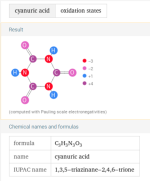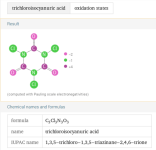I have a curious question about the CYA in my indoor pool. By the time I discovered this site and made the conversion from Trichlor tablets to liquid chlorine in May 2022 my CYA had creeped up to about 50ppm. This was after a full water replacement when a new liner was installed in November 2020.
Based on the CYA-FC charts from this forum I then targeted and maintained my FC between 6 and 8 for the next 18 months - surrendering to the fact that my CYA would remain around 50ppm for the long term. During this time, my water remained clear, stable and with no signs of black algae or mold. I also performed a small 15% no-drain water exchange in May 2022 and it had a similar 15% reduction in the CYA. But I have not done any further exchanges. But then - throughout 2023 I was noticing that my CYA was slowly decreasing and is now at a level I can no longer detect on my K-2006C test kit. When I had the water tested at my local pool store in October 2023 it was 7ppm on their test system.
In October, I began to slowly lower my target FC and I have been managing it at around 2.0 to 2.5 for several weeks - with still no issues in water clarity or algae. The water only needs about 8oz to 12oz (depending on age of chlorine) of the 12.5% sodium hypochlorite per day.
I am quite happy about all of this but it was my understanding that CYA will not normally decrease on its own in an indoor pool that is covered for probably 95% of the time. There is no splash-out with this minimally used pool and I only need to add a 1/2" of water every few months or after a backwash - so further dilution is not a likely candidate for causing this.
Any ideas what might have happened? Thanks.
Latest Test Result Summary:
FC: 2.2
CC: 0.0
pH: 7.7
TA: 150
CYA: undetectable
Water Temp: 89°
Based on the CYA-FC charts from this forum I then targeted and maintained my FC between 6 and 8 for the next 18 months - surrendering to the fact that my CYA would remain around 50ppm for the long term. During this time, my water remained clear, stable and with no signs of black algae or mold. I also performed a small 15% no-drain water exchange in May 2022 and it had a similar 15% reduction in the CYA. But I have not done any further exchanges. But then - throughout 2023 I was noticing that my CYA was slowly decreasing and is now at a level I can no longer detect on my K-2006C test kit. When I had the water tested at my local pool store in October 2023 it was 7ppm on their test system.
In October, I began to slowly lower my target FC and I have been managing it at around 2.0 to 2.5 for several weeks - with still no issues in water clarity or algae. The water only needs about 8oz to 12oz (depending on age of chlorine) of the 12.5% sodium hypochlorite per day.
I am quite happy about all of this but it was my understanding that CYA will not normally decrease on its own in an indoor pool that is covered for probably 95% of the time. There is no splash-out with this minimally used pool and I only need to add a 1/2" of water every few months or after a backwash - so further dilution is not a likely candidate for causing this.
Any ideas what might have happened? Thanks.
Latest Test Result Summary:
FC: 2.2
CC: 0.0
pH: 7.7
TA: 150
CYA: undetectable
Water Temp: 89°




